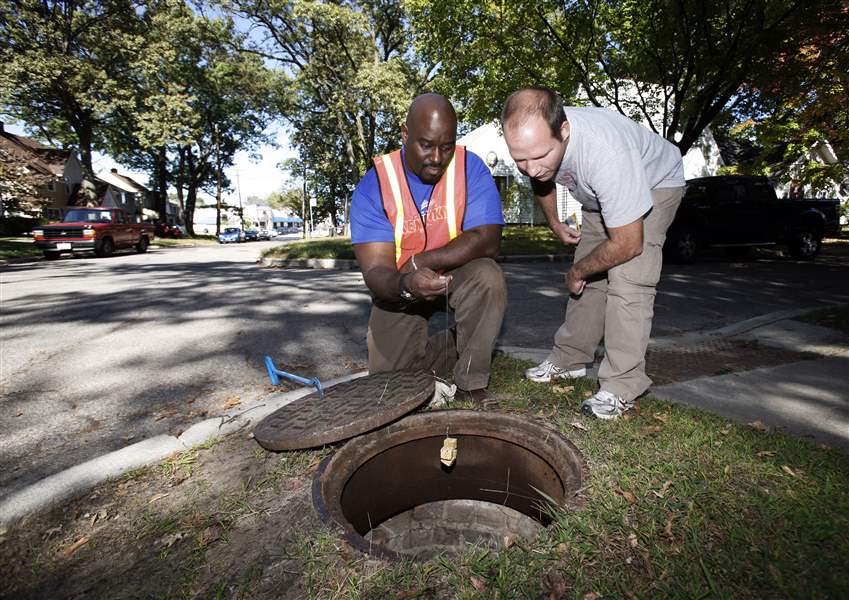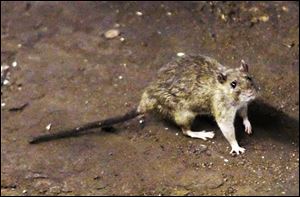
Rats on the move in West Toledo
10/3/2010
Vaughn Jackson, left, and Brian Hahn, registered sanitarians with the Toledo health department, drop rat poison down a manhole in West Toledo.
The Blade/Andy Morrison
Buy This Image

Vaughn Jackson, left, and Brian Hahn, registered sanitarians with the Toledo health department, drop rat poison down a manhole in West Toledo.
2010 is shaping up as the year of the rat for some West Toledoans living south of Sylvania Avenue.
City and Lucas County officials say they've been inundated with complaints about rats running the streets, scurrying across yards, and invading homes and crawl spaces.
Some are even burrowing beneath dog houses and raiding dogs' food bowls.
The likely culprits for the infestation: sewer and Interstate construction work, and the large number of unsold vacant properties, officials said.
“This was the first summer that rat complaints outpaced noise complaints,” said Toledo City Councilman Tom Waniewski, who represents District 5.
He said he's receiving one to two e-mails a day about rat problems.
“There is nothing that grosses people out more than cockroaches and rats,” Mr. Waniewski said.
One of the worst-hit areas is the neighborhood around the old DeVilbiss High School and I-475.
The Ohio Department of Transportation recently razed about 60 properties between the high school and freeway as part of an I-475 widening and modernization projection.

Most of the rats seen in Toledo are Norway rats and seem to enjoy sewer living as much as underground burrows, said a health department official.
Ever since, Brian Vanderhorst of nearby Giant Street feels that he has been fighting an invasion of homeless rats seeking new habitat.
He often awakes to find rat pellets on the floor, and can smell rat urine in the air.
“They are all over the place,” Mr. Vanderhorst, 33, said. “I've got a lot of traps set and my dogs have been catching them. In the past two months, [my dog] caught six or seven of them in the house.”
Residents' complaints caught the ear of Mr. Waniewski, who last month notified Mayor Mike Bell's staff about the gnawing problem.
Within days the city and the Toledo-Lucas County Health Department began a rat abatement program to target the worst-affected West Toledo neighborhoods.
By Friday, a two-man rodent control crew had baited 199 manhole covers with blocks of rodent poison.
Toledo's rats seem to enjoy sewer living as much as underground burrows, said Alan Ruffell, director of the health department's environmental health division.
The rodent crew moved east to west, setting a total of nearly 85 pounds of rat poison from Baltimore Street to Secor Road, between Sylvania Avenue and I-75 and I-475.
The target zone included stretches of Sylvania Avenue and Berdan Avenue that have undergone sewer construction projects.
“Anytime you're moving that much dirt, the rats are scared from the place they're living and we start to see activity,” Mr. Ruffell said.
Crew member Brian Hahn, 37, said the ones he's seen in Toledo are Norway rats, also known as sewer rats.
“They are good-sized rats, very similar to what you'd see in New York or Chicago,” Mr. Hahn said.
Mr. Waniewski also worries that vacant houses contribute to the infestation; his district has 102 vacant properties.
Mr. Vanderhorst has been setting rodent poison around a vacant house and garage on his street that once attracted so many rats that neighbors could see the trails the animals cut through the overgrown grass.
Bill Gall, an owner of Frame's Pest Control on Rood Street, said his rodent calls have held steady at about 8 to 10 a week, although he still gets more calls about mice than rats.
He recently visited a property where rats had burrowed under a doghouse and were sneaking food from the dog bowl. There is no extermination spray for rats, so he laid out poison to kill them.
Stahlwood Avenue resident Debbie Muranyi, who also lives near the I-475 construction, once saw four or five rats grabbing food from her Siberian husky's dish.
Reluctant to lay out poison for fear that the dog might get it, her husband set a spring-loaded trap with peanut butter and Cheerios — snaring a rat about a foot long.
Mrs. Muranyi said she hasn't seen many rats around her house since her dog died this year.
She's not mourning their absence; “It's scary. The rats here have been very large.”
Mr. Ruffell of the health department said he is unaware of any recent rat bites in the county.
Yet Mr. Gall can tell of a near miss that involved a friend who was cleaning out a barn in Swanton.
His friend came upon a rat and proceeded to back the rodent into a corner.
“And that doggone rat came right back up the broomstick at him,” Mr. Gall said.
The health department hopes that the city's switch to an automated trash collection system will eventually reduce the rodent population, because rats can't gnaw through the refuse containers as they are able to do with plastic bags.
Contact JC Reindl at:jreindl@theblade.com or 419-724-6065.